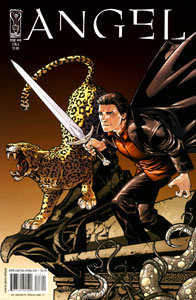When IDW first picked up the “Angel” license, it delivered hesitant stories – with the exception of the “Spike” titles – up until the canonical Joss Whedon-plotted “After the Fall” (Issues 1-17 of the ongoing series). Embarking on the remainder of the “Angel” ongoing series (which will go up to Issue 44), IDW is back to being unsure of how it wants to proceed. The opener, “Aftermath,” is the worst “Angel” comic arc up to this point, and while it gets better after that, there’s little forward momentum for the main title in 2009.
“Aftermath” (Issues 18-22, February-June 2009)
Writer Kelley Armstrong and artist Dave Ross were not the best choices to launch the post-“ATF” period, as the former is getting a feel for comic writing (in an interview at the back of Issue 16, she says she’s new to it) and the latter struggles with likenesses. Armstrong takes an “X-Men” team-creation approach and selects Angel, Kate, Connor and Gwen for this adventure, while adding her own inventions, the jaguar-human shapeshifter Dez and the angel James (yep, with wings and everything).
That Spike, Illyria and Gunn are otherwise occupied is no problem, since they have spinoff titles around this time, but since Nina was tight with Connor’s group in “After the Fall,” her absence is odd. Kate and Angel meeting for the first time since Season 2 should be a big deal, but they basically nod and say hello. I would’ve liked more elaboration on what she’s been up to since then, but the worst offense regarding Kate is that she doesn’t look or dress like Kate. She sports police-style body armor, but with an inexplicable bare midriff.
Connor has decided he hates Gwen’s guts, and he doesn’t give an inch. This is understandable for a while, as Gwen had sided with vampire Gunn in “After the Fall.” But Connor is being a hypocrite: He once buried his dad alive in the ocean, for crying out loud. As per the magic of “After the Fall,” Connor’s full memories have been restored, but does he feel remorse about his behavior when he was under the influence of Holtz? Maybe not, but Armstrong doesn’t explore this.
“Aftermath” finds a relaunched Angel Investigations setting up in a church, which has a nice irony to it, but it makes no logistical sense for Angel to live and work in a place that will perpetually torment him. The concept of someone being born an animal but shifting into human form is interesting (and reminiscent of Splinter in “TMNT”), but the story doesn’t do much with it. Honestly, the most compelling thing about Dez is the logistics of her clothing: When she morphs into a jaguar, she needs someone to keep her clothes nearby, or she’ll be naked when she morphs back – and then Ross has to draw her with strategic shadows.
Just figuring out what’s happening in “Aftermath” is a chore. This five-parter would’ve played better as one or two straightforward issues, without the unnecessary obfuscation about characters’ intentions. You can’t skip them, as Dez and James will be major players in future issues, but you’ll wish you could have.
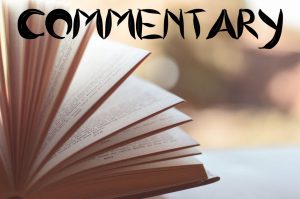
1.5 stars
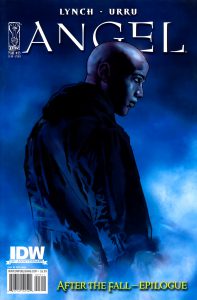
“After the Fall – Epilogue” (Issue 23, July 2009)
The IDW “Angel” all-star team of Brian Lynch and Franco Urru is back to get Gunn on his feet in this issue that bridges “After the Fall” and the “Angel: Only Human” miniseries. Everyone remembers the events of “After the Fall,” but Gunn’s situation is the most fascinating: He’s human again, but he remembers being a vampire. He has a soul again, but he remembers the taste of blood and his desire to end the world.
The villain Non (from “Spike: After the Fall”), back to life like everyone else, restores Gunn’s full health, hoping to ally with him, but it’s Illyria whom he’s drawn to. Illyria offers to kill Gunn, but he declines the offer, knowing it would make her feel remorse. Everything is fascinatingly backward when Lynch delves into the feelings of post-vampire Gunn and wannabe-human Illyria, and I look forward to following this duo into “Only Human.”
4 stars
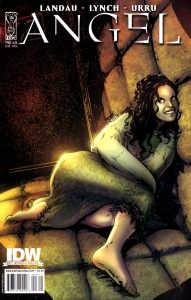
“Drusilla” (Issues 24-25, August-September 2009)
Juliet Landau co-writes these two issues with Lynch, making her the third Buffyverse actor to write for their character in comics, following James Marsters and Amber Benson (and preceding Nicholas Brendon’s work on “Buffy” Season 10). We learn what Drusilla has been up to since we last saw her in “Angel” Season 2 /“Buffy” Season 5, but it’s through Dru’s POV, so honestly, who knows what we’re seeing?
Before The Fall of L.A., the vampire is in an asylum of sorts, being studied by official-seeming scientists in the vein of The Initiative. Then Dru gradually retreats into her own headspace, influenced by the magic forces of The Fall to illustrate on paper (conveniently in Urru’s style) what’s happening outside the facility’s walls. Drusilla is very much in character as she gleefully slaughters all the workers, but we never learn this organization’s purpose, and the story is left awkwardly incomplete. But Dru will return in IDW’s eight-issue “Spike” series, so we’ll file away our knowledge of this secret facility for now.
3 stars
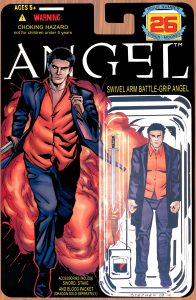
“Boys and Their Toys” (Issues 26-27, October-November 2009)
In “After the Fall,” it sometimes seemed like Lynch wanted to go full-blown comedic, but the nature of the story held him back. The “Spike” comics allow him to be a little looser, but Spike’s situations are pretty dire, too. “Boys and Their Toys” feels like a conscious reaction to those darker yarns as Lynch brings Angel, Spike, Groo and Jeremy to a Comic-Con knockoff in San Diego to explore the vampires’ newfound celebrity.
Artist Stephen Mooney turns things around in a big way from his mediocre work as a fill-in artist on “After the Fall.” Right off the bat, accurate likenesses are crucial to selling the first joke: In the Hollywood movie based on the Fall of L.A., Angel is played by Nicolas Cage, Gunn by the guy who played Hurley on “Lost” (!), and Spike by Reese Witherspoon (!!).
And in the second major gag, a riff on “Halloween” (“Buffy” 2.6), Spike thinks he’s Angel because he’s wearing an Angel mask when a magic spell kicks in. Mooney sells all of this, matching Spike’s sharp cheekbones with Angel’s spiked hair into “Spangel,” and Lynch taps into the humorous irony of Spike’s ongoing Angel complex. Spike admires Angel but doesn’t admit it, while also thinking he’s superior to him because he earned his soul rather than being cursed with it.
The comedy of this two-part side trip is on point, but I have a nagging feeling that the “Angel” title has no idea where it wants to go with the overall narrative moving forward, as this arc makes no mention of what’s happening back in L.A. with the team of Kate, Connor, Gwen, Dez and James. Hopefully that will change with the next batch of issues.
3.5 stars
Click here for an index of all of John’s “Buffy” and “Angel” reviews.

